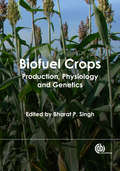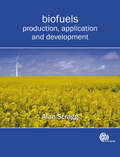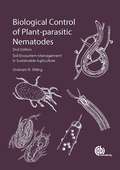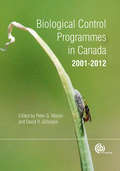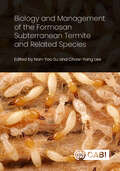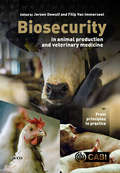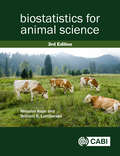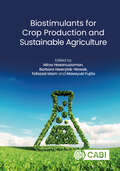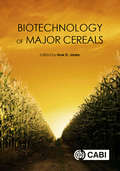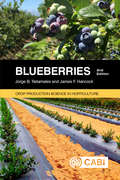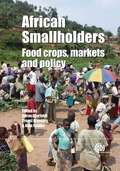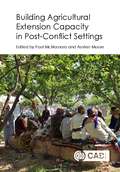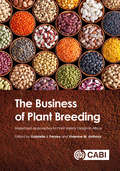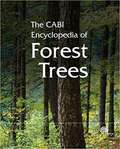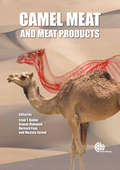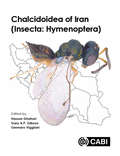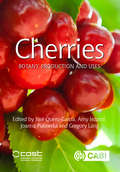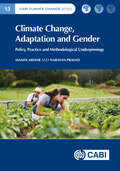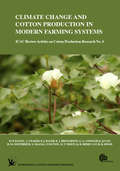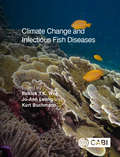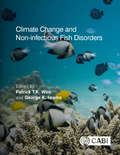- Table View
- List View
Biofuel Crops
by Sujata Bhargava T K Biswas S Wani Steven E Mckeand Toshihiko Yamada Ralph Sims Ismail Dweikat Natalie S Betts Caitlin S Byrt L A Moraes S Hemaiswarya C Dana Nelson Belum V Reddy Jagannath Vishnu Patil Holger Schuhmann Somashekhar Punnuri Gary Stephan Banuelos N K Fageria Bharat Singh John H Fike C M Williams Martin Weih Robert B Rummer Rachel A Burton Isabel S Carvalho P Srinivasa Rao Eric J Jokela Donald L Rockwood M Czako Ryan P Viator Peer M Schenk Bill Kovarik Leslie H Groom K C Falk A Moreira Kossonou Guillaume Anzoua Eric Obeng Christopher Q Lan Karaj Singh Dhillon R Raja J G Isebrands C Ganesh Kumar A V Umakanth Pratik Satya Masazumi Kayama David J Parrish Surinder S Banga Naser Farrokhi Ratikanta Maiti Anna Hale Gary F Peter R Ravikumar Serge Bracconnier Hari P Singh P J Minogue Kurt H Johnsen C Eynck L Marton K MuthukumarappanProviding comprehensive coverage on biofuel crop production and the technological, environmental and resource issues associated with a sustainable biofuel industry, this book is ideal for researchers and industry personnel. Beginning with an introduction to biofuels and the challenges they face, the book then includes detailed coverage on crops of current importance or with high future prospects, including sections on algae, sugar crops and grass, oil and forestry species. The chapters focus on the genetics, breeding, cultivation, harvesting and handling of each crop.
Biofuel Crops: Production, Physiology and Genetics
by Kossonou Guillaume Anzoua Surinder S Banga Gary Stephan Banuelos Natalie S Betts Sujata Bhargava T K Biswas Serge Bracconnier Rachel A Burton Caitlin S Byrt Isabel S Carvalho M Czako Karaj Singh Dhillon Ismail Dweikat C Eynck N K Fageria K C Falk Naser Farrokhi J G Isebrands John H Fike Leslie H Groom Anna Hale S Hemaiswarya Ratikanta Maiti Kurt H Johnsen Eric J Jokela Masazumi Kayama Bill Kovarik C Ganesh Kumar Christopher Q Lan L Marton Steven E McKeand P J Minogue L A Moraes A Moreira K Muthukumarappan C Dana Nelson Eric Obeng David J Parrish Jagannath Vishnu Patil Gary F Peter Somashekhar Punnuri R Raja P Srinivasa Rao R Ravikumar Belum V Reddy Donald L Rockwood Robert B Rummer Pratik Satya Ralph Sims Hari P Singh S Wani Peer M Schenk Holger Schuhmann A V Umakanth Ryan P Viator Martin Weih C M Williams Toshihiko YamadaProviding comprehensive coverage on biofuel crop production and the technological, environmental and resource issues associated with a sustainable biofuel industry, this book is ideal for researchers and industry personnel. Beginning with an introduction to biofuels and the challenges they face, the book then includes detailed coverage on crops of current importance or with high future prospects, including sections on algae, sugar crops and grass, oil and forestry species. The chapters focus on the genetics, breeding, cultivation, harvesting and handling of each crop.
Biofuels
by Alan ScraggProviding the world's growing population with its increasing demands for energy is a major challenge for science, business and society alike. Energy can be generated from many sources, but not all sources are suitable for every application. Much of today's technology has been built on solid, liquid and gaseous fuels derived from fossil sources. However, the supply of these is finite and their combustion produces carbon dioxide, one of the gases responsible for global warming. Therefore, alternative sources of energy are required which are renewable, sustainable and carbon neutral. This textbook explores the production of biofuels as alternatives to fossil fuels, focusing on the technological issues that need to be addressed for any new fuel source. Each type of biofuel currently in production is considered in detail, covering the benefits and problems with production and use and the potential for biological material to provide sufficient energy for the world's population - the principles on which future fuel development are based.
Biological Control of Plant-parasitic Nematodes
by Graham StirlingPlant-parasitic nematodes are one of multiple causes of soil-related sub-optimal crop performance. This book integrates soil health and sustainable agriculture with nematode ecology and suppressive services provided by the soil food web to provide holistic solutions. Biological control is an important component of all nematode management programmes, and with a particular focus on integrated soil biology management, this book describes tools available to farmers to enhance the activity of natural enemies, and utilize soil biological processes to reduce losses from nematodes.
Biological Control of Plant-parasitic Nematodes: Soil Ecosystem Management in Sustainable Agriculture
by Graham StirlingPlant-parasitic nematodes are one of multiple causes of soil-related sub-optimal crop performance. This book integrates soil health and sustainable agriculture with nematode ecology and suppressive services provided by the soil food web to provide holistic solutions. Biological control is an important component of all nematode management programmes, and with a particular focus on integrated soil biology management, this book describes tools available to farmers to enhance the activity of natural enemies, and utilize soil biological processes to reduce losses from nematodes.
Biological Control Programmes in Canada 2001-2012
by Rob Bourchier Alec Mcclay Joan Cossentine Tara D Gariepy Rob Mcgregor Peter Mason Guy Boivin Barry Lyons Kevin D Floate Charles Vincent Tim Haye Rosemarie De Clerck-Floate Naomi Cappuccino Christian Hébert Gary Peng Jacques Brodeur Howard Thistlewood David R Gillespie Jean J Turgeon Gilles Boiteau Paul Abram John Gavloski Dave Langor Bruce Broadbent Laura Timms Neil Holliday Alan Watson Sue M Boyetchko Martin Erlandson Hector CárcamoCanada is a world leader in biological control research. Reporting the status of biocontrol agents released in Canada over the last decade, this book presents case studies by target pest that evaluate the impact of biocontrol and recommend future priorities. In addition to a new chapter on future targets and an appendix listing established agents, this edition contains information of interest to a global audience, and chapters that address effects of invasive species and climate change.
Biological Control Programmes in Canada 2001-2012
by Tara D Gariepy Sue M Boyetchko Kevin D Floate Barry Lyons Jean J Turgeon Jacques Brodeur Rob McGregor Hector Cárcamo Tim Haye Joan Cossentine Paul Abram Neil Holliday Howard Thistlewood John Gavloski Dave Langor Charles Vincent Christian Hébert Gilles Boiteau Naomi Cappuccino Guy Boivin Bruce Broadbent Laura Timms Martin Erlandson Alan Watson Rob Bourchier Rosemarie De Clerck-Floate Alec McClay Gary PengCanada is a world leader in biological control research. Reporting the status of biocontrol agents released in Canada over the last decade, this book presents case studies by target pest that evaluate the impact of biocontrol and recommend future priorities. In addition to a new chapter on future targets and an appendix listing established agents, this edition contains information of interest to a global audience, and chapters that address effects of invasive species and climate change.
Biology and Management of the Formosan Subterranean Termite and Related Species
by Thomas Chouvenc J. Kenneth Grace Claudia Husseneder Shuji Itakura Hou-Feng Li Nathan Lo Kok-Boon Neoh Wakako Ohmura Faith M. Oi Rudolf H. Scheffrahn Qian Sun Gaku Tokuda Edward L. Vargo Chia-Chien Wu Koichi YamamotoThe Formosan subterranean termite, Coptotermes formosanus, is the most destructive and invasive termite species globally. It is also the only termite species listed in the world's 100 worst invasive alien species of the Global Invasive Species Database. Annually, its infestation costs more than $4 billion in control and damage repairs in the USA alone. This book is the first comprehensive resource drawing on all the literature on C. formosanus since Tokuichi Shiraki first described the species in 1909. The book covers the worldwide distribution of this species, its biogeography, and how it has dispersed from its native range in southern China and Taiwan to different parts of the world. It describes its present taxonomic status and discusses the species' biology, ecology, foraging behavior, physiology, chemical ecology and its association with symbionts. From a practical standpoint, the authors address all of the various management options for this species, such as baits, soil termiticides, wood preservatives, inspection and detection technologies, and Integrated Pest Management (IPM) approaches. Lastly, there are chapters dedicated to another important destructive species, Coptotermes gestroi (the Asian subterranean termite), and the recently discovered C. formosanus/C. gestroi hybrids. This important book is an essential and valuable reference for researchers, graduate students, pest management professionals, chemical manufacturer personnel, building and property managers, and others. It provides readers with a comprehensive understanding of the biology and management of the Formosan subterranean termite and the Asian subterranean termite.
Biosecurity in Animal Production and Veterinary Medicine: From principles to practice
by Jeroen Dewulf Filip Van ImmerseelGlobally, the way the animal production industry copes with infectious diseases is changing. The (excessive) use of antimicrobials is under debate and it is becoming standard practice to implement thorough biosecurity plans on farms to prevent the entry and spread of pathogenic micro-organisms. Not only in farm animal production, but also in facilities where companion animals are kept, including in veterinary practices and clinics, awareness of the beneficial implications of a good biosecurity plan has raised. The book Biosecurity in Animal Production and Veterinary Medicine is the first compilation of both fundamental aspects of biosecurity practices, and specific and practical information on the application of the biosecurity measures in different animal production and animal housing settings. The book starts with a general introductory chapter on the epidemiology of infectious diseases, followed by a chapter explaining the general principles of biosecurity. Specific topics of biosecurity, including rodent and insect control, cleaning and disinfection, hygiene and decontamination of feed, drinking water and air, and measuring the biosecurity status of farms, are detailed in dedicated chapters. Explanations on the relevance of the implementation of biosecurity plans in order to improve animal health and performance and reduce antimicrobial usage are described, and a chapter on ways to motivate farmers to implement a biosecurity plan has been included. Practical chapters deal with biosecurity in the poultry, pig and cattle industry, horse facilities, dog kennels, veterinary practices and clinics and laboratory animal facilities. The book is a practical guide that can be used by farm and animal facility managers, consultants, veterinarians, animal caretakers, and people with an interest in prevention of diseases in animals. Academics and students will benefit from the book because it contains all relevant information on animal biosecurity.
Biostatistics for Animal Science, 3rd Edition
by Miroslav Kaps William R. LambersonDesigned to cover techniques for analysis of data in the animal sciences, this popular textbook provides an overview of the basic principles of statistics enabling the subsequent applications to be carried out with familiarity and understanding. Each chapter begins by introducing a problem with practical questions, followed by a brief theoretical background. Most topics are followed up with numerical examples to illustrate the methods described using data-sets from animal sciences and related fields. The same examples are then solved using the SAS software package. Key features of this third edition: - Updated throughout, and covers a wealth of new distributions and new material on non-normal dependent variables - Improved clarity of text and examples - Includes both basic techniques and more complex procedures to provide an essential resource whatever your level - Contains exercises and many worked examples in SAS. Written primarily for students and researchers in animal sciences, the text is also useful for those studying agricultural, biological, and veterinary sciences.
Biostimulants for Crop Production and Sustainable Agriculture
by Mirza Hasanuzzaman Barbara Hawrylak-Nowak Tofazzal Islam Masayuki FujitaAgricultural biostimulants are a group of substances or microorganisms, based on natural resources, that are applied to plants or soils to improve nutrient uptake and plant growth, and provide better tolerance to various stresses. Their function is to stimulate the natural processes of plants, or to enrich the soil microbiome to improve plant growth, nutrition, abiotic and/or biotic stress tolerance, yield and quality of crop plants. Interest in plant biostimulants has been on the rise over the past 10 years, driven by the growing interest of researchers and farmers in environmentally-friendly tools for improved crop performance. Focusing on recent progress on biostimulants and their role in crop production and agricultural sustainability, this book includes: 31 chapters on a wide range of biostimulants and their role in plant growth stimulation and stress tolerance. Mechanism of actions of diverse groups of biostimulants, such as trace elements, plant and seaweed extracts, humic substances, polyamines, osmolytes, vitamins, nanoparticles and microorganisms. New promising biostimulants with novel modes of action. Improved crop production technologies are urgently needed to meet the growing demand for food for the ever-increasing global population by addressing the impacts of changing climate on agriculture. This book is of interest to researchers in agriculture, agronomy, crop and plant science, soil science and environmental science.
Biotechnology of Major Cereals
by Huw D. JonesBiotechnology of Major Cereals will focus on the recent advances and future prospects in cereal biotechnology. The first part of the book will cover the world's major cereals and focus on new developments and trends. The second part will be technology rather than species-led, detailing fundamental developments in technologies and significant target traits.
Blueberries 2nd Edition (Crop Production Science In Horticulture)
by Jorge B. RetamalesThis new and updated edition covers major topics of interest to blueberry breeders and researchers: botany, physiology, nutrition, growth regulation, photosynthesis, environment, weeds, pests, diseases and postharvest management. The focus is on the highbush blueberry, though information on other blueberries and related species is also provided. <P><P>Blueberries are cultivated worldwide and this book explores plantings in a great diversity of environments, reflecting on the development of innovative cultural practices and conditions. It examines the increased scope and depth of research activities related to this crop and brings together the current status of knowledge on blueberry science and management. Explaining in an understandable manner the basic science behind the growth and development of blueberries, their botanical characteristics, as well as the implications and effects of various management practices and environmental conditions, the second edition of Blueberries also: <P><P> • Highlights emerging genetic information on the blueberry • Includes new information on pruning, grafting and irrigation • Covers current and potential uses of plant growth regulators • Gathers new information on fruit quality and consumer acceptance <P><P>Key Features: <P><P> • The definitive guide to blueberry cultivation for researchers, growers and breeders • Updated to reflect the latest developments in the industry • Comprehensive coverage of botanical, physiological and management of cultivated blueberries
Bread, Beer and the Seeds of Change
by Carol Sinclair Thomas SinclairThe history of humankind is intimately tied to the history of agriculture: powerful societies rose, persisted and waned in parallel with their food supply systems. Describing what crops were grown, the constraints on their production and the foods that were obtained, this book traces the impact of cropping and food preparation in ten societies that were among the most powerful and influential in history, detailing how technology varied and developed as it related directly to agriculture and food production. The book covers the background of agricultural development, early agricultural societies, and the advancement of technology from the ancient Greeks and Romans to the present. It finishes by addressing the implications for the future of agriculture and food supply as grain production moves towards biofuels. A compelling text for all those interested in the history of society and civilisations, global agriculture, and what it means for the future, this text is also an essential reference for students of agriculture, food technology, history and anthropology.
Building Agricultural Extension Capacity in Post-Conflict Settings
by Paul E. Mcnamara Austen MooreThis book (a) investigates the experiences and issues involved with extension systems in post-conflict settings, (b) evaluates the impact of different extension policy approaches and practice in such settings, and (c) identifies the key elements needed to effectively rebuild agricultural extension systems and programs in post-conflict contexts. The chapters contain country-specific case studies that provide a descriptive account but also analyze strategies, successes and failures, and lessons learned. A synthesis chapter provides comparative analysis of insights across post-conflict settings. Overall, the book serves as a collective volume for use by governments, practitioners, and academics in extension policy-making and programming, and contributes to post-conflict, political science, and agricultural extension literatures.
The Business of Plant Breeding
by G. J. Persley V. M. AnthonyThe Business of Plant Breeding is the result of a study on demand-led plant variety design for markets in Africa, sharing best practices from private and public sector breeding programmes worldwide that are applicable to improving tropical crops in Africa. Beginning with an overview of the principles of demand-led plant breeding, the book then discusses aspects such as understanding the demands of clients and markets in rural and urban areas, foresight in setting product profiles and breeding targets, and determining breeding strategy and stage plans. It also covers measuring success and making the business case for future investments in breeding programmes that will deliver new varieties to meet market demands. The book: - Brings together the experience of plant breeders around the world, representing universities, national plant breeding programmes, regional and international agricultural research institutes, and private seed companies, showcasing how to respond to changing market demands; - Provides educational resource materials within each chapter; - Includes templates for use as planning tools by plant breeding programs for determining priority traits that meet market demands. An important read for professionals and students of plant breeding and genetics, this book is also a useful resource for anyone interested in developing and disseminating new, market-led technologies to increase productivity and profitability in tropical agriculture. The study was sponsored by the Australian Centre for International Agricultural Research, the Crawford Fund and the Syngenta Foundation for Sustainable Agriculture, and managed by the University of Queensland.
CABI Encyclopedia of Forest Trees
by Cabi Cabi Nick PasiecznikThe CABI Encyclopedia of Forest Trees provides an extensive overview of 300 of the world's most important forest trees. Tropical, subtropical, temperate and boreal trees of major economic importance are included, covering tree species used in agroforestry practices around the world. Many of the species covered are considered to be 'multipurpose' trees with uses extending beyond timber alone; the land uses such as watershed protection or provision of windbreaks, and non-wood uses such as the production of medicines, resins, food and forage, are also listed. Comprehensive information is presented on each tree's importance, with a summary of the main characteristics of the species, its potential for agroforestry use and any disadvantages it possesses. The tree's botanical features such as habit, stem form, foliage, inflorescence, flower and fruit characters and phenology are covered in detail with over 70 colour plate pictures to aid identification. Also included are specific sections devoted to pests and diseases, distribution and silvicultural characteristics and practices, including seed sowing, nursery care, planting, thinning, and harvesting. In addition to the wealth of information detailed, based on datasheets from CABI's Forestry Compendium, selected references for further reading are provided for each entry, making this book an essential reference work for forestry students, researchers and practitioners.
Camel Meat and Meat Products
by Bernard Faye Osman Mahgoub Mohammed Tageldin Msafiri Mbaga David Favis-Mortlock A Bekhit Mustafa Farouk Isam KadimCamel meat has many benefits as a meat product. It has low fat content and is highly nutritious, and has potential to be used to combat hyperacidity, hypertension, pneumonia and respiratory disease. This book reviews up-to-date literature on camel meat and meat products, carcass and meat quality characteristics, muscle structure, post-mortem analysis and the nutritive value to humans. A comparatively small component of global meat consumption, camel meat has the potential to undergo an explosion of production worldwide, and currently farming for camel meat in Asia, Africa, Latin America and Australia is undergoing significant expansion. The potential of camel meat in helping to meet projected world food shortages, and being sustainably farmed, is also explored by the editors.
Chalcidoidea of Iran (Insecta: Hymenoptera)
by Hassan Ghahari Gary A.P. Gibson Gennaro ViggianiThe superfamily Chalcidoidea (Insecta, Hymenoptera) contains in excess of 26,000 described species worldwide, but with an estimated total diversity of more than 500,000 species the vast majority of species have yet to be discovered and described. Most chalcidoid species are parasitoids of hosts in at least 12 different insect orders, attacking the egg, larval or pupal stages, though phytophagy and other life cycles and hosts are known. Iran is the 18th largest country in the world and has a rich and diverse insect fauna, including Chalcidoidea. It is extremely interesting from a biogeographic point of view, and a paradise for an entomologist. This book summarizes the results of all prior research concerning species diversity of Iranian Chalcidoidea, including host records and distribution records by province in Iran as well as world distribution by country for 1,351 species of Chalcidoidea recorded from Iran through the end of 2019. The faunal diversity for each of the 20 families of Chalcidoidea known from Iran is also compared with that known for 15 adjacent countries. In addition, general information on world diversity, recognition, phylogenetic relationships and host relationships are given for each family. As such, the book will be an invaluable source of information for all those involved with chalcidoids, for anyone with an interest in insect systematics, and all those working in crop protection, especially biological control and Integrated Pest Management.
Cherries
by J. Quero-García Amy Iezzoni Joanna Puławska Gregory LangSweet and sour cherries (Prunus avium and Prunus cerasus) are important fruit crops for which demand is high and growing. A significant number of new varieties, rootstocks and training systems have been released or developed in recent years in order to improve the efficiency and profitability of cherry orchards. Cherries: Botany, Production and Uses covers the genetics, ecophysiology, production, protection and uses of cherries. Presenting up-to-date scientific data and applied information, this book is invaluable for researchers, teachers and all professionals working in the cherries value chain.
Climate Change, Adaptation and Gender: Policy, Practice and Methodological Underpinnings (CABI Climate Change Series #17)
by Dr Mamta Mehar Professor Narayan PrasadThis book offers a wide, in-depth study of the gender-climate change-agriculture nexus. The crux of understanding these connections comprises gender equality and tools to measure gender discrimination, the evolution of the concept of gender inclusiveness and its concerns; and the need to address the same by formulating gender-inclusive policymaking. Despite the fact that more than 50 years have elapsed since gender concerns were included in explorations of this nexus, there is still ambiguity around the foundations, connections, and approaches for planning gender-inclusive climate policies. This book aims to clear that ambiguity by: · Being the first to explore exclusively this issue in detail. · Revealing how and why consideration of gender is so important for understanding how climate change impacts rural communities and agricultural systems globally. · Exploring every dimension of climate change (including belief systems and perceptions, knowledge, experience, coping strategies, adaptation, and mitigation strategies) and linking it to gender. It includes new theoretical and methodological approaches that go far beyond the household as the unit of analysis (using various approaches, including intersectional analysis). The book not only throws light on major themes of research, but also covers different methodologies ranging from review methods to mathematical models, conceptual frameworks and empirical analysis. It will be of wide interest to students, scholars, and researchers in gender studies, agriculture, climate change and rural development research, and also to practitioners, extension workers, and planners designing new climate-resilient practices.
Climate Change and Cotton Production in Modern Farming Systems
by K. J. Broughton Q. Luo D. M. Oosterhuis Y. Osanai P. Payton D. T. Tissue B. K. Singh P. Bauer K Reddy Michael P Bange G. Constable J. BakerThroughout the world cotton is broadly adapted to growing in temperate, sub-tropical, and tropical environments, but growth may be challenged by future climate change. Production may be directly affected by changes in crop photosynthesis and water use due to rising CO2 and changes in regional temperature patterns. Indirect effects may result from a range of government regulations aimed at climate change mitigation. While there is certainty that future climate change will impact cotton production systems; there will be opportunities to adapt. This review begins to provide details for the formation of robust frameworks to evaluate the impact of projected climatic changes, highlight the risks and opportunities with adaptation, and details the approaches for investment in research. Ultimately, it is a multi-faceted systems-based approach that combines all elements of the cropping system that will provide the best insurance to harness the change that is occurring, and best allow cotton industries worldwide to adapt. Given that there will be no single solution for all of the challenges raised by climate change and variability, the best adaptation strategy for industry will be to develop more resilient systems. Early implementation of adaptation strategies, particularly in regard to enhancing resilience, has the potential to significantly reduce the negative impacts of climate change now and in the future.
Climate Change and Cotton Production in Modern Farming Systems (ICAC Reviews)
by Michael P Bange J. Baker P. Bauer K. J. Broughton G. Constable Q. Luo D. M. Oosterhuis Y. Osanai P. Payton D. T. Tissue K Reddy B. K. SinghThroughout the world cotton is broadly adapted to growing in temperate, sub-tropical, and tropical environments, but growth may be challenged by future climate change. Production may be directly affected by changes in crop photosynthesis and water use due to rising CO2 and changes in regional temperature patterns. Indirect effects may result from a range of government regulations aimed at climate change mitigation. While there is certainty that future climate change will impact cotton production systems; there will be opportunities to adapt. This review begins to provide details for the formation of robust frameworks to evaluate the impact of projected climatic changes, highlight the risks and opportunities with adaptation, and details the approaches for investment in research. Ultimately, it is a multi-faceted systems-based approach that combines all elements of the cropping system that will provide the best insurance to harness the change that is occurring, and best allow cotton industries worldwide to adapt. Given that there will be no single solution for all of the challenges raised by climate change and variability, the best adaptation strategy for industry will be to develop more resilient systems. Early implementation of adaptation strategies, particularly in regard to enhancing resilience, has the potential to significantly reduce the negative impacts of climate change now and in the future.
Climate Change and Infectious Fish Diseases
by Patrick T.K. Woo Jo-Ann Leong Kurt BuchmannClimate change with global warming is not disputed by the vast majority of scientists and the aquatic system is most affected. A global rise in water temperature and acidification of the aquatic environment will continue even if we can significantly reduce the current output of the two most important greenhouse gasses (carbon dioxide and methane). These and other environmental changes will affect fish health which includes infectious pathogens. This important new text is the second volume on climate change and fish health. It covers changes to the freshwater ecosystem and their current and expected effects on selected infectious diseases of fish. The book represents contributions by over 50 experts from 18 countries. Comprehensive and thought-provoking, the book details abiotic and biotic environmental changes in temperate and tropical freshwater ecosystems, sequestrations of atmospheric carbon dioxide and effects on infectious diseases (12 microbial and 10 parasitic) in economically important fish in tropical, subtropical and temperate waters. The text is key reading for fish disease scientists, aquatic ecologists, fish health consultants, veterinarians, policy makers and all who are interested in fish health and the environment.
Climate Change and Non-infectious Fish Disorders
by Kevin B. Strychar Paul W. Sammarco Jani Ti Tanzil Seng Keat Ooi Serene Hx Tay Yan Xiang Ow Siew Chin Chua Esther Clews Annette Bolton Srivatsan Raghavan Shie-Yui Liong Clara Boglione Akinyi Carol Nyaoke Hélène Volkoff Rune Waagbø Pål A. Olsvik Sofie C Remo Robert J Lennox Jacob W. Brownscombe Chris K. Elvidge Philip Harrison Kathryn Peiman Graham D. Raby Steven J. Cooke Erin Faught Juan Hernandez-Perez Jonathan Wilson Mathilakath M Vijayan Pedro M.G. Guerreiro Sveinung Fivelstad Asbjørn Bergheim Anne Berit Olsen John Colt Willem B MuiswinkelAn important new title on climate change, and its effects on selected non-infectious disorders of fish. Contains contributions by internationally recognized experts who have contributed significantly to our knowledge in this area.
